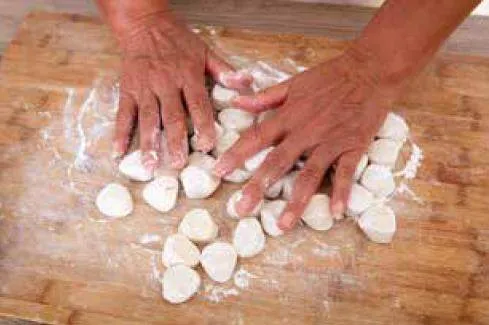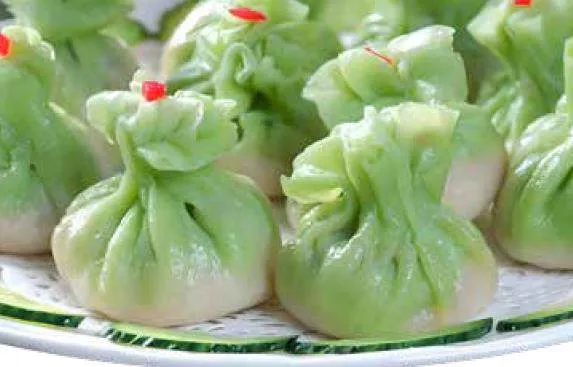呼和浩特的特色美食
2024-01-01玉明






呼和浩特位于内蒙古自治区中部,是自治区的首府,也是一座历史悠久的草原古城。这里地域辽阔,自然资源丰富,是以游牧为生的蒙古族人民繁衍生息的家园。在长期的民族交往中,呼和浩特的饮食文化与各地的风味饮食相互融合,形成了游牧民族独具特色的饮食文化,其中有一些很有代表性,比如烧卖和莜面。
Located in the central part of the Inner MongoliaAutonomous Region, Hohhot is the region’s capitaland an ancient city with a rich grassland heritage.This vast land, rich in natural resources, has longbeen home to the nomadic Mongolian people.Through centuries of cultural exchange, Hohhot’sfood culture has blended with various regional flavorsto create a distinctive culinary tradition unique tothe nomadic lifestyle. Two dishes that best representthis fusion are shaomai (steamed dumplings) andyoumian (oat noodles).
烧卖
Shaomai
烧卖在中国传统饮食文化中有着悠久的历史,而且早已是遍布大江南北的中华传统面点。在中国各地,人们都能吃到不同风味的烧麦。但说到烧麦的起源,据传它最早来自清朝时期的绥远地区,也就是现在的呼和浩特市。烧麦是呼和浩特人尤为钟爱的美食之一,在呼市的大街小巷,随处可见烧卖馆。既有老字号“麦香村”,也有价格亲民、深受百姓喜爱的街头小巷中的小店。清晨时分,人们常常三两成群地围坐在一起,一边悠闲地饮茶、聊天,一边品尝着美味的烧麦,开启美好的一天。
Shaomai has a long history in China’s traditionalfood culture and is now a staple across the country.While shaomai can be enjoyed in many differentstyles, its origins are said to trace back to theSuiyuan region during the Qing Dynasty, which isnow modern-day Hohhot. In Hohhot, shaomai isa beloved local delicacy, and shaomai shops can befound on nearly every street. Some are well-knownbrands, like the old establishment “Maixiangcun,”while others are more affordable, down-to-earth spotsthat locals love. In the early morning, it’s commonto see people gathering in small groups, sipping tea,chatting, and enjoying delicious shaomai as they starttheir day.
制作烧卖比包饺子更简单。传统烧卖以烫面为皮,中间放入馅料。无需包裹,一提即成形。皮薄馅大,形状像个杯子,底部是圆的,腰部收细,上面如同花边。馅料可以是各种肉类和蔬菜,蒸熟后香味浓郁。烧卖的制作技艺各地区差异不大,区别主要在于馅料的选取和样式。
Making shaomai is simpler than makingdumplings. Traditional shaomai uses dough that hasbeen scalded with hot water to form the wrapper,which is then filled with various ingredients. It doesn’tneed to be tightly sealed — just a pinch and the shapeforms. The wrapper is thin, the filling generous, andthe shape resembles a small cup: round at the base,thin at the waist, and edge at the top. The filling canbe made with different types of meat and vegetables,and once steamed, the aroma is mouthwatering.While the techniques for making shaomai don’t varymuch across regions, the main differences lie in the choice of fillings and presentation.
传统的呼和浩特烧卖,羊肉是其最重要的原料,葱、姜为必备品。传统烧卖流传至今,不仅是因为其丰富的营养价值,更重要的是,烧卖中的羊肉馅料经过烹饪加工后形成的浓郁风味深受人们的喜爱。内蒙古地区的羊肉肉质鲜嫩、营养无膻、肥而不腻,这也是羊肉成为呼和浩特烧卖馅料首选的原因。在品种上烧卖可分为凤尾鲜虾烧卖、花朵烧卖、养颜烧卖、翡翠烧卖、蛋皮烧卖与白菜烧卖等。
In traditional Hohhot shaomai, lamb is the mainingredient, with green onion and ginger as essentialflavorings. The enduring appeal of shaomai lies notonly in its nutritional value, but more importantlyin the rich and savory flavor that comes from thelamb filling after cooking. Inner Mongolian lambis renowned for being tender, nutritious and freeof gamey flavor, rich but not greasy. These qualitiesmake it the first choice for shaomaistuffing in Hohhot. In terms ofappearance, shaomai comesin various styles, includingphoe nixtails hrimpshaomai, flower shaomai,beauty shaomai, jadeshaomai, egg wrappedshaomai and cabbageshaomai.
莜面
Youmian
莜面是主要流行于我国华北和西北部分地区的一种食粮。位于阴山北麓的呼和浩特市武川县是莜面的主要产地。这里日照时间长,昼夜温差大,降水集中,非常适合莜麦的生长。因此莜麦制成的莜面,也成了武川县的一道特色美食。相传,清朝康熙皇帝品尝莜面后,对其赞不绝口。乾隆年间,武川的莜面还作为贡品,被送往京城供皇帝享用。
Youmian is a staple food primarily popularin northern and northwestern China. WuchuanCounty, located at the northern foothills of the YinMountains near Hohhot, is the main production areafor youmian. The region’s long hours of sunlight, largetemperature differences between day and night, andconcentrated rainfall make it an ideal environmentfor growing oats. As a result, youmian made fromWuchuan’s oats has become a local specialty. Legendhas it that after tasting youmian, Emperor Kangxi ofthe Qing Dynasty couldn’t stop praising it. Duringthe Qianlong reign, Wuchuan’s youmian was evenpresented as a tribute to the imperial court for theemperor’s enjoyment.
莜面的制作手法灵活多变,经过搓、推、擀、卷,可以翻新出不同的花样。烹饪方法更是有蒸、炸、汆、烙、炒等。莜面制作的食物品种非常丰富,单是蒸品就有窝窝、鱼鱼、墩墩、圪团等近20种。莜面传统的吃法有冷吃和热吃两种,此处的冷热主要是指莜面所用蘸汤的冷热。冷吃法,一般配上腌菜、葱花、芫荽,连同用胡麻油炝好的辣椒面一同倒入碗中。辣乎乎,红彤彤,吃起来那叫一个爽。热吃法的汤料则更丰富,比如用鸡蛋羹、酸菜山药条、蘑菇、羊肉、牛肉等做成的汤底。两种吃法,完全取决于莜面的类型和个人的口味。此外,餐馆里的莜面多在明档厨房现场制作。吃莜面前,观赏一番民间手艺,更是令人食欲大增。
The process of makingyoumian is creative, withtechniqu e s l ike rol l i ng,pushing, kne ading, andtwisting that produce a variety of shapes and styles. The cooking methods are equallydiverse, including steaming, frying, boiling, baking,and stir-frying. There are nearly 20 types of steamedyoumian dishes alone, such as wowo, yuyu, dundun,and getuan. Traditionally, youmian can be eateneither cold or hot, depending on the temperature ofthe dipping sauce. For the cold version, it’s usuallypaired with pickled vegetables, chopped greenonions, and cilantro, all mixed in a bowl with chiliflakes fried in flaxseed oil. The spicy red sauce makesfor an incredibly satisfying dish. The hot versionfeatures a richer broth, often made with ingredientslike egg custard, sour cabbage with yam strips,mushrooms, lamb, or beef. Whether you choose thecold or hot version depends on the type of youmianand your taste. In many restaurants, youmian is madefresh in open kitchens, where you can watch thetraditional techniques in action — adding a touchof entertainment before the meal that makes theexperience even more appetizing.
蒙古族饮食文化的形成与自然条件和经济、政治等社会因素有着密不可分的关联。蒙古族饮食文化一方面吸收其他民族的优秀文化,一方面也把本民族的文化弘扬出去。烧麦风靡全国,莜面被端上中国大江南北的餐桌,都是这样的例子。再如,吃全羊是蒙古族的传统习俗,但也汲取了汉族的烹调技艺,从而成为蒙汉文化交流的结晶。经过南北交流、民族融合、东西交汇,蒙古族饮食文化正在传承与创新中打造出更多品牌。
Mongolian cuisine is closely linked to theregion’s natural environment as well as its economicand political factors. It has evolved by incorporatingthe best of other cultures, while spreading its owntraditions. For example, shaomai has becomepopular nationwide, and youmian is now a commondish on tables across China. Another exampleis the Mongolian custom of eating whole lamb,which has been enhanced by the adoption of HanChinese cooking techniques, making it a symbol ofMongolian-Han cultural exchange. As this exchangebetween north, south, east and west continues,Mongolian cuisine is being passed down andinnovated, creating ever more distinctive culinarybrands.
